Last week, John Deere held a press event near Magdeburg, Germany to showcase its suite of existing technologies and software-based solutions and how they can be integrated to aid productivity and increase efficiency of a cropping cycle. From this, results-based decisions can be made for the following crop, thus increasing sustainability.
Called the Leap Ambition – the company has set goals and offers farmers technologies and solutions that provide economic as well as sustainable benefits to help meet the looming political demands.
In order to demonstrate the potential, the company focused on the small grain production cycle which was used to demonstrate how fertiliser, pesticides and CO2 can be saved/reduced at every step of the process, from sowing to fertilising, crop care and harvesting.
HarvestLab and grain sensing
Analysing crop yield is critical so that results-based decisions can be made to benefit the following crop. Well-known for use on foragers, John Deere is now offering its near-infrared sensor (NIR) HarvestLab system on its T and S series combines for live analysis of grain yield and constituents. In doing so, crop quality and nutrient content can be measured by determining moisture, starch, protein and oil content.

For grain sensing, the HarvestLab unit is fitted on the combine’s grain elevator.
This yield related data is then recorded and mapped in the John Deere Operations Centre.
From here, nutrient removal values can be determined on a site-specific basis so that fertilisation requirements of the subsequent crops can be established in a variable rate format.
Instead of blanket-spreading crops with inputs such as chemical N, it is instead only placed where it is needed, resulting in a more uniform crop and N savings.
In order to grain sense, machines already equipped with JD link and a StarFire receiver require the HarvestLab 3000 sensor, fitting kit and a one-time activation key. Customers who already have a HarvestLab unit only require the fitting kit and activation key to begin grain sensing. The bare HarvestLab 3000 unit is priced at €15,990 (£15,191) plus VAT, while the combine fitting kit is €2,500 (£2,375) plus VAT followed by €2,990 (£2,841) plus VAT for the one-time grain-sensing activation key.
John Deere also showcased the capabilities of HarvestLab to measure and record the slurry N, P and K values applied. Using yield maps from harvest, satellite imagery or drone images, slurry or chemical fertiliser can then be applied at a variable rate and distribute nutrients site-specifically.
AutoPath
John Deere showcased its latest AutoPath application to ensure dependable precision within row crops every pass after the first. Both the implement and tractor are equipped with StarFire receivers to precisely record the location of the actual row location rather than a static AB Line, which may or may not actually represent the planted row due to implement drift which tends to be the case on side hills and around curves.
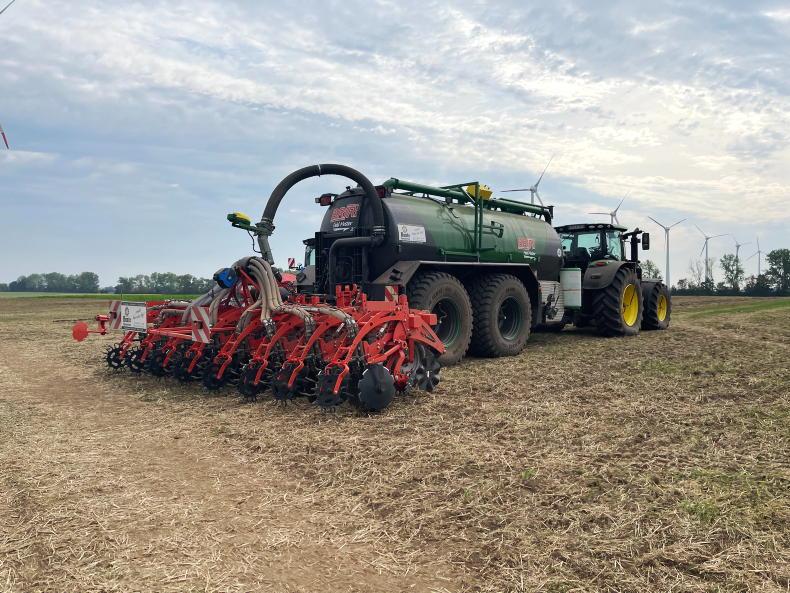
AutoPath records actual row location rather than a static AB Line which may or may not actually represent the planted row due to implement drift.
The application was demonstrated working through a number of operations including strip till slurry injection, followed by direct precision planting and mechanical weeding.
Positioning from the first pass is recorded in the operations centre and made available to all the other tractors within the fleet. After digging up a sample, slurry was placed at a depth of 10cm to 12cm and the seed exactly above it 7cm from the surface.
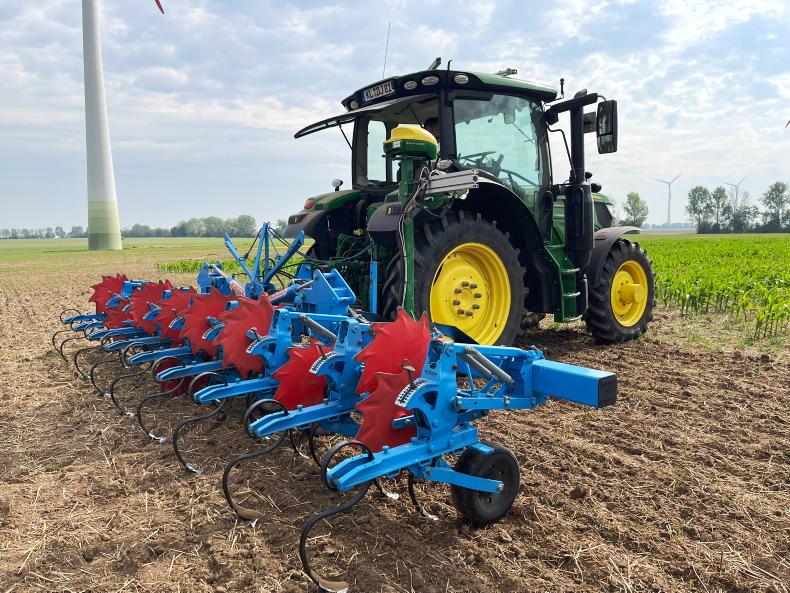
Using AutoPath, mechanical weeding can take place accurately at speeds up to 16km/h.
Digital control of mechanical
weed control
John Deere demonstrated its current crop care technologies which are driven by the changing market and requirements under upcoming EU regulation to reduce the use of chemical plant protection products.
Traditionally, mechanical weeding was considered a time-consuming task due to the precision required to avoid interference with the crop. The speed and success of herbicide and sprayers then took over. Almost full circle, we are back to mechanical weeding methods. However, as demonstrated, the use of auto-steering guidance technology and applications like AutoPath means mechanical weeding can now be carried out more accurately and at speeds up to 16km/h.
For complete accuracy, the hoe was also fitted with a StarFire GPS receiver to communicate with the tractor mounted receiver. The hoe which is considered an active implement was set up to move independently of the tractor and adjusts laterally up to 24cm. In this case, a hydraulic cylinder replaced the stabiliser arms to create the lateral movement.
Most trailed implements such as slurry tankers and injection units, given their nature, compensate via the tractor’s steering. AutoPath is included in the Generation 4 automation bundle and available for either the 4600 CommandCenter Integrated Display or the 4640 Universal Display.
Spot spraying
Moving on from section control, individual nozzle control on the R900i sprayer series offers greater precision to sub-areas and even individual plants.
Nozzles are switched on and off using solenoid valves in their 25cm or 50cm spacings, while a high-pressure recirculation system means pressure remains constant regardless of how many nozzles are on or off.
Using third-party drone imagery or satellite maps, weed location can be detected within a particular field in terms of density and disease pressure. From this, weed maps are created and transferred to the sprayer via operations centre. Once in operation these sub-areas are the only areas to be sprayed. According to John Deere, up to 77% reductions in herbicide can be achieved using such technology.
This solution is available on the higher-specification R900i Series trailed sprayers, which are now available in 4,400l, 5,200l and 6,200l tank sizes. The R900i PowrSpray feature sees two hydraulically driven centrifugal pumps. The first fills the sprayer at up to 1,200 litres/min, while the second, a 1,000l/min spraying pump, has direct rate control for fast changes of application rate and the highest spraying accuracy.
John Deere said it believes in a future consisting of both mechanical weed control and spot spraying practices working together.
eAutoPowr for
flagship 8Rs
John Deere demonstrated its latest eAutoPowr transmission on the day. It claims to be the world’s first IVT transmission with electro-mechanical power split. Up until now, 8R models above the 400hp mark could not be specified with the AutoPowr IVT option.
The hydraulic element of the transmission has been replaced with two electric brushless motors which from a technical aspect simplifies the design of the transmission, proving themselves in over 100,000 hours of field testing.
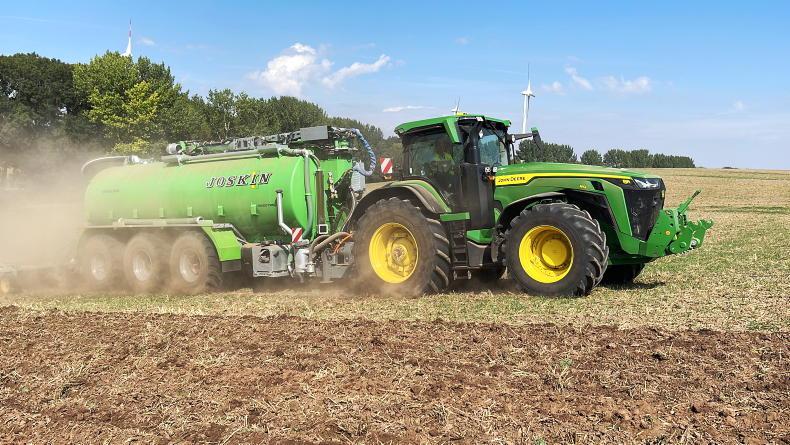
With eAutoPower the hydraulic element of the transmission has completed been replaced with two electric brushless motors.
As an option, the eAutoPowr unit can provide up to 100kW of electrical power for external implements via a 480V variable-frequency three-phase current (AC). Deere has worked in partnership with Joskin to develop a 28,000l slurry tanker with electric drive axles to make use of the off-boarding transmission feature. Two of the tanker’s axles are powered using one motor via the tractor’s e-port and thus the weight of the tanker can be used for traction.
Slurry injection
For the purpose of the demonstration, the driver showed two uphill slurry injection applications with and without electric off-boarding engaged.
When not engaged, slippage reached 60% to 70% before the system was engaged compared to a steady 8% to 10% figure, while the tanker’s axles were powered. The slip limit can be set by the driver so that the electrical drive engages automatically.
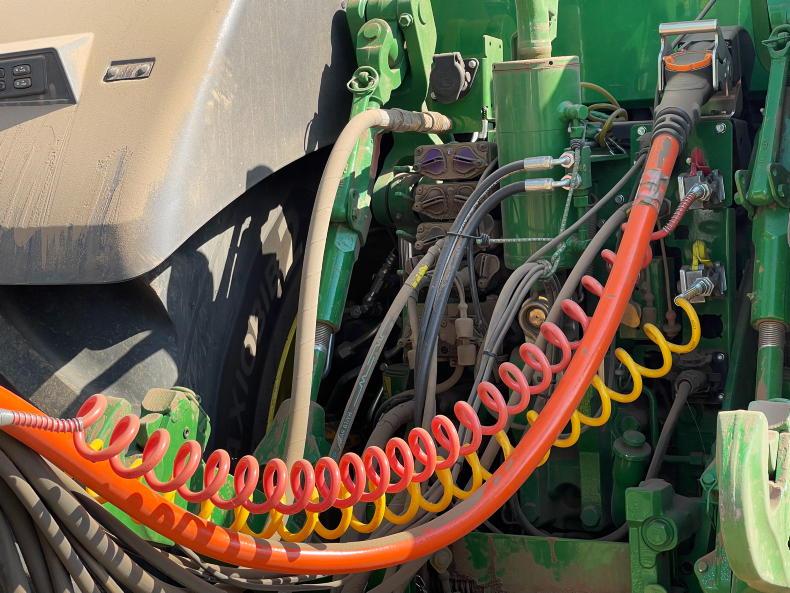
The off-boarding options provides up to 100kW of AC power for external implements.
According to Deere, noise levels within the cab are said to have been reduced. Speeds of up to 5km/h are completely electrically driven. The eAutoPowr option adds an additional 400kg to 500kg to the tractor which the firm says, along with its larger size, is the main reason that the transmission is only available on the flagship 8R tractor and not likely to be offered on smaller models and ranges.
The IVT eAutoPowr tractors are due to go into production this coming November for delivery early next year. The transmission comes as a €22,586 (£21,457) plus VAT option on the 8R410, with power off-boarding costing a further €21,450 (£20,378) plus VAT.
In summary
With a wide range of technology and software solutions currently on offer, John Deere wants to show farmers and contractors how all its solutions can be integrated under the umbrella of its operations centre to benefit farming practices such as grain production right through from planting to crop care and harvesting. The data gathered along the way is relayed back to the operations centre, recorded and broken down, so that actions can be made ahead of the next cropping cycle. In theory, as a result, farmers have the potential to reduce inputs, improve yields and farm more sustainably.
Last week, John Deere held a press event near Magdeburg, Germany to showcase its suite of existing technologies and software-based solutions and how they can be integrated to aid productivity and increase efficiency of a cropping cycle. From this, results-based decisions can be made for the following crop, thus increasing sustainability.
Called the Leap Ambition – the company has set goals and offers farmers technologies and solutions that provide economic as well as sustainable benefits to help meet the looming political demands.
In order to demonstrate the potential, the company focused on the small grain production cycle which was used to demonstrate how fertiliser, pesticides and CO2 can be saved/reduced at every step of the process, from sowing to fertilising, crop care and harvesting.
HarvestLab and grain sensing
Analysing crop yield is critical so that results-based decisions can be made to benefit the following crop. Well-known for use on foragers, John Deere is now offering its near-infrared sensor (NIR) HarvestLab system on its T and S series combines for live analysis of grain yield and constituents. In doing so, crop quality and nutrient content can be measured by determining moisture, starch, protein and oil content.

For grain sensing, the HarvestLab unit is fitted on the combine’s grain elevator.
This yield related data is then recorded and mapped in the John Deere Operations Centre.
From here, nutrient removal values can be determined on a site-specific basis so that fertilisation requirements of the subsequent crops can be established in a variable rate format.
Instead of blanket-spreading crops with inputs such as chemical N, it is instead only placed where it is needed, resulting in a more uniform crop and N savings.
In order to grain sense, machines already equipped with JD link and a StarFire receiver require the HarvestLab 3000 sensor, fitting kit and a one-time activation key. Customers who already have a HarvestLab unit only require the fitting kit and activation key to begin grain sensing. The bare HarvestLab 3000 unit is priced at €15,990 (£15,191) plus VAT, while the combine fitting kit is €2,500 (£2,375) plus VAT followed by €2,990 (£2,841) plus VAT for the one-time grain-sensing activation key.
John Deere also showcased the capabilities of HarvestLab to measure and record the slurry N, P and K values applied. Using yield maps from harvest, satellite imagery or drone images, slurry or chemical fertiliser can then be applied at a variable rate and distribute nutrients site-specifically.
AutoPath
John Deere showcased its latest AutoPath application to ensure dependable precision within row crops every pass after the first. Both the implement and tractor are equipped with StarFire receivers to precisely record the location of the actual row location rather than a static AB Line, which may or may not actually represent the planted row due to implement drift which tends to be the case on side hills and around curves.

AutoPath records actual row location rather than a static AB Line which may or may not actually represent the planted row due to implement drift.
The application was demonstrated working through a number of operations including strip till slurry injection, followed by direct precision planting and mechanical weeding.
Positioning from the first pass is recorded in the operations centre and made available to all the other tractors within the fleet. After digging up a sample, slurry was placed at a depth of 10cm to 12cm and the seed exactly above it 7cm from the surface.

Using AutoPath, mechanical weeding can take place accurately at speeds up to 16km/h.
Digital control of mechanical
weed control
John Deere demonstrated its current crop care technologies which are driven by the changing market and requirements under upcoming EU regulation to reduce the use of chemical plant protection products.
Traditionally, mechanical weeding was considered a time-consuming task due to the precision required to avoid interference with the crop. The speed and success of herbicide and sprayers then took over. Almost full circle, we are back to mechanical weeding methods. However, as demonstrated, the use of auto-steering guidance technology and applications like AutoPath means mechanical weeding can now be carried out more accurately and at speeds up to 16km/h.
For complete accuracy, the hoe was also fitted with a StarFire GPS receiver to communicate with the tractor mounted receiver. The hoe which is considered an active implement was set up to move independently of the tractor and adjusts laterally up to 24cm. In this case, a hydraulic cylinder replaced the stabiliser arms to create the lateral movement.
Most trailed implements such as slurry tankers and injection units, given their nature, compensate via the tractor’s steering. AutoPath is included in the Generation 4 automation bundle and available for either the 4600 CommandCenter Integrated Display or the 4640 Universal Display.
Spot spraying
Moving on from section control, individual nozzle control on the R900i sprayer series offers greater precision to sub-areas and even individual plants.
Nozzles are switched on and off using solenoid valves in their 25cm or 50cm spacings, while a high-pressure recirculation system means pressure remains constant regardless of how many nozzles are on or off.
Using third-party drone imagery or satellite maps, weed location can be detected within a particular field in terms of density and disease pressure. From this, weed maps are created and transferred to the sprayer via operations centre. Once in operation these sub-areas are the only areas to be sprayed. According to John Deere, up to 77% reductions in herbicide can be achieved using such technology.
This solution is available on the higher-specification R900i Series trailed sprayers, which are now available in 4,400l, 5,200l and 6,200l tank sizes. The R900i PowrSpray feature sees two hydraulically driven centrifugal pumps. The first fills the sprayer at up to 1,200 litres/min, while the second, a 1,000l/min spraying pump, has direct rate control for fast changes of application rate and the highest spraying accuracy.
John Deere said it believes in a future consisting of both mechanical weed control and spot spraying practices working together.
eAutoPowr for
flagship 8Rs
John Deere demonstrated its latest eAutoPowr transmission on the day. It claims to be the world’s first IVT transmission with electro-mechanical power split. Up until now, 8R models above the 400hp mark could not be specified with the AutoPowr IVT option.
The hydraulic element of the transmission has been replaced with two electric brushless motors which from a technical aspect simplifies the design of the transmission, proving themselves in over 100,000 hours of field testing.

With eAutoPower the hydraulic element of the transmission has completed been replaced with two electric brushless motors.
As an option, the eAutoPowr unit can provide up to 100kW of electrical power for external implements via a 480V variable-frequency three-phase current (AC). Deere has worked in partnership with Joskin to develop a 28,000l slurry tanker with electric drive axles to make use of the off-boarding transmission feature. Two of the tanker’s axles are powered using one motor via the tractor’s e-port and thus the weight of the tanker can be used for traction.
Slurry injection
For the purpose of the demonstration, the driver showed two uphill slurry injection applications with and without electric off-boarding engaged.
When not engaged, slippage reached 60% to 70% before the system was engaged compared to a steady 8% to 10% figure, while the tanker’s axles were powered. The slip limit can be set by the driver so that the electrical drive engages automatically.

The off-boarding options provides up to 100kW of AC power for external implements.
According to Deere, noise levels within the cab are said to have been reduced. Speeds of up to 5km/h are completely electrically driven. The eAutoPowr option adds an additional 400kg to 500kg to the tractor which the firm says, along with its larger size, is the main reason that the transmission is only available on the flagship 8R tractor and not likely to be offered on smaller models and ranges.
The IVT eAutoPowr tractors are due to go into production this coming November for delivery early next year. The transmission comes as a €22,586 (£21,457) plus VAT option on the 8R410, with power off-boarding costing a further €21,450 (£20,378) plus VAT.
In summary
With a wide range of technology and software solutions currently on offer, John Deere wants to show farmers and contractors how all its solutions can be integrated under the umbrella of its operations centre to benefit farming practices such as grain production right through from planting to crop care and harvesting. The data gathered along the way is relayed back to the operations centre, recorded and broken down, so that actions can be made ahead of the next cropping cycle. In theory, as a result, farmers have the potential to reduce inputs, improve yields and farm more sustainably.











 This is a subscriber-only article
This is a subscriber-only article






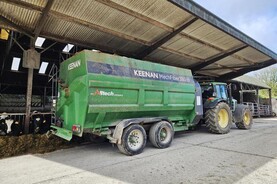


SHARING OPTIONS: